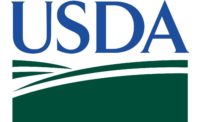"Consumers should be able to make an informed choice in the store, which is why we need to provide clear, informative labels that will help consumers make the best decisions about feeding their families," said Under Secretary for Food Safety Dr. Elisabeth Hagen. "It has become evident that some raw meat and poultry labels, even those that follow our current guidelines, may not be clear."
Currently, raw meat and poultry products that contain added solutions such as water, teriyaki sauce, salt, or a mixture thereof may have the same name on their labels as products that do not contain added solutions. For example, a single-ingredient chicken breast and a chicken breast with added solution both may be labeled as "chicken breast," even though one package contains purely chicken breast and one may be comprised of 60 percent chicken breast and 40 percent solution. While the label of the chicken breast with added solution must state that it contains solution, consumers may not notice such information if it is not a part of the product's name. An example of a product name under the proposed rule would be: "chicken breast – 40% added solution of water and teriyaki sauce."
The agency has tentatively concluded that, without specific, clear, and conspicuous information about the percentage of added solution incorporated into the product, the labeling of these raw meat or poultry products is likely to mislead consumers. The proposed rule would require that the common or usual name of these products include an accurate description of the raw meat or poultry component, the percentage of added solution, and the individual or multi-ingredient components in the added solution. The print for such labels would be presented in a font, size, and color that are easily visible to consumers.
The proposed rule was posted on the FSIS website (www.fsis.usda.gov/regulations_&_policies/
Proposed_Rules/index.asp) and soon will publish in the Federal Register. Comments must be received on or before 60 days from publication in the Federal Register and may be submitted through the Federal eRulemaking Portal at www.regulations.gov, or by mail to the U.S. Department of Agriculture, FSIS Docket Clerk, Room 2-2127, George Washington Carver Center, 5601 Sunnyside Ave., Mailstop 5272, Beltsville, M.D. 20705. All comments must identify FSIS and docket number FSIS-2010-0012.
The American Meat Institute issued a statement on the proposed rule, calling it “unnecessary.” AMI President and CEO J. Patrick Boyle issued the following statement:
“President Obama in January wrote in the Wall Street Journal that regulatory initiatives should solve problems, not create new ones. USDA’s new proposal to change the labeling of many raw meat and poultry products, while adding no new information not already required on the label, is both unnecessary and wasteful.
“USDA has a long-established prior label approval system that requires government officials to reject false and misleading labels before they are applied to federally inspected meat and poultry products. The labels that are the subject of this new, burdensome proposal have been in the marketplace for years with USDA approval.
“In order to ensure that consumers know that some ready-to-cook meat and poultry products contain added solutions, long-standing FSIS labeling regulations have required that these added solutions be identified on the front of the label contiguous to the identification of the product, such as chicken breasts or pork tenderloin, yet in a smaller and different font. Simply stated, today’s proposal would make the font bigger and move it closer to the product’s name.
“In other words, as an example, a package currently labeled 'CHICKEN BREASTS' with a qualifier in the package corner stating, 'Enhanced with up to 20% of a solution of water, salt and spices,' would be replaced with, 'CHICKEN BREASTS ENHANCED WITH UP TO 20% OF A SOLUTION OF WATER, SALT AND SPICES.'
USDA estimates the resulting redesign and reprinting of the current labels and packaging will cost $73 million. As a result, the far more significant change on the label that consumers will notice will be the price of the product.
“President Obama described his regulatory reform initiative as removing regulations ‘that are not worth the cost, or that are just plain dumb.’ This $73 million dollar label redesign and font size change very much evokes those words.”
Source: FSIS, AMI




Report Abusive Comment